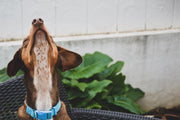Why Do Dogs Eat Grass?
Your dog is supposed to be a carnivore, right? Descended from wolves and all that? So what the heck is she doing chowing down on grass like she thinks she’s a sheep?
Lots of Theories, Few Hard Facts
Various theories have been proposed to answer the question of why dogs eat grass (it’s a pretty common occurrence: most dog owners report that their dogs eat grass at least occasionally). Boredom is one suggestion. Another is that dogs eat grass because they aren’t feeling well and eating grass will make them vomit. The flaw in the latter theory is that dogs may or may not be able to think through the complicated logic of connecting vomiting with making your dog feel better after he eats something disagreeable.
Besides, the strong digestive acids in a dog’s stomach mean there aren’t actually that many things they consume that they can’t handle. The other problem is that very often dogs that eat grass don’t actually vomit afterwards, so if that is their motivation grass-eating doesn’t seem to be a particularly good solution.
Nutritional Deficits May Lead to Grass-Eating in Dogs
Meeting a nutritional or dietary need is another reason why dogs may eat grass, though scientific studies are lacking when it comes to proving this theory one way or the other. Because it’s high in fibre, consuming some grass may help provide the roughage a dog needs in order to maintain healthy digestion.
Should You Be Worried if Your Dog Eats Grass?
Not necessarily. Wild dogs and wolves have also been observed eating grass as well as the stomach contents of their grass-eating prey, so it seems like it’s probably a natural behaviour. Wild canine ancestors may have eaten grass to increase intestinal contractions as a way to help get rid of parasites. Though most domestic dogs no longer carry a large parasite load, the behaviour may be left over from days when their ancestors did.
Not All Grass is Created Equal
What you should worry about is if your dog has access to toxic plants or is eating grass contaminated by pesticides, something that’s all too common in urban environments. Some plants that are toxic to dogs include crocuses, azaleas, daffodils, tulips, and palms.
Consider Growing Grass for Your Dog
If your pup really loves grass (because, yes, some dogs eat grass just because they like the taste or texture) but you can’t be sure their green snacks are uncontaminated, consider starting a small grass plantation just for your dog. Place the growing containers close to your dog’s food bowl and, if necessary, spray other houseplants with an anti-chewing spray. If you want to make your own natural chew-deterrent, try mixing equal parts of white vinegar and apple cider vinegar in a spray bottle. Add a bit of lemon juice for extra punch. Just be careful not to accidentally spray your dog with this concoction.
Rawmate Provides Roughage and Complete Nutrition
In some cases, changing a dog’s diet reduces the urge to eat grass. Rawmate, raw dog food meals, include plenty of fibre along with high-quality naturally raised meat and all the vitamins and minerals your dog needs to stay healthy. For more answers to questions about dog training, care, or nutrition, keep browsing the Rawmate blog where we we do our best to answer common questions from dog owners just like you!








There are 0 Comments